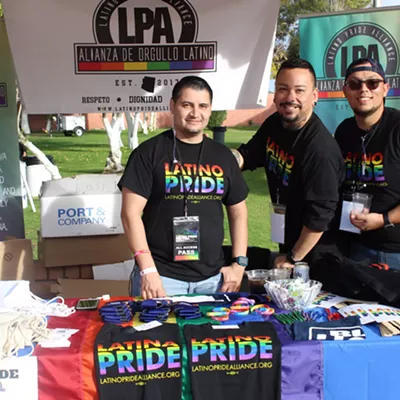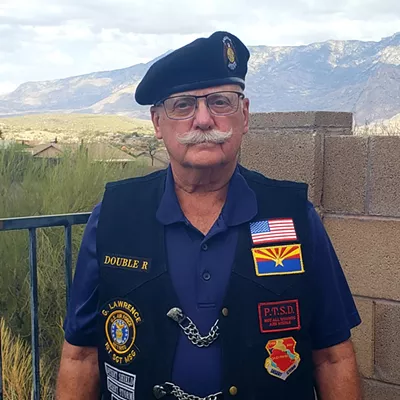Pedestrians passing beneath a casino-advertising billboard in the 5000 block of South 12th Avenue shouldn't look up. If they do, they'll be gambling that there aren't any pigeons about to poop on them from above.
According to the city of Tucson, this billboard, which displays two 672-square-foot signs, was illegally built many years ago over the public right of way. Not only that, but the billboard was also allegedly installed without a permit, violates setback and spacing regulations, and is too tall.
If a legal settlement now pending between the city and the billboard's current owner, Clear Channel Outdoor, is approved, the sign will be coming down.
City Attorney Mike Rankin says he plans to discuss the proposed settlement with the City Council in an executive session on April 21, and Rankin recently told Superior Court Judge Carmine Cornelio: "I don't schedule (an item) for the mayor and council unless there's something real to talk about."
The framework for the proposed legal settlement was outlined in a memorandum of understanding (MOU) signed by Rankin and a representative of Clear Channel Outdoor last October. It would bring an end to a lawsuit which began almost a decade ago and involved close to 200 billboards that the city claimed were illegal.
The settlement proposal calls for more than 100 of these billboards to eventually be removed—a significant reduction of Clear Channel Outdoor's current total of about 370 advertising signs within city limits.
About 40 percent of the billboards that would be removed, including the one on 12th Avenue, would come down within a year of the settlement's completion. Another 30 percent would be gone between one and three years later, and the remainder could remain for up to 15 years.
In addition, 23 of the billboards covered by the settlement would be modified. These changes include relocating some of them, and reducing the height of others.
Under the terms of the MOU, approximately 70 billboards included in the original city lawsuit would be deemed legal.
"Assuming all the details can be worked out," comments attorney Joy Herr-Cardillo, "this is a win-win situation. ... The Billboard Review Committee is feeling good about it."
Herr-Cardillo is a member of that citizens' group, which was instrumental in negotiating a 2006 billboard settlement between Clear Channel Outdoor and Pima County. The committee is now involved with the negotiations between City Hall and the billboard company.
Herr-Cardillo emphasizes that enforcement of the city's sign code hasn't been compromised by the settlement; she calls that "a win for everyone."
Architect Kathy McLaughlin, also a member of the committee, agrees.
"If the committee's recommendations are followed," McLaughlin says of the details still to be ironed out, "this will be a settlement we can live with."
However, those yet-to-be-settled details are significant, like defining what it means to replace structural items on a billboard by a "like kind" of material.
"Wood can't be replaced by metal," McLaughlin says as an example.
She also says that Clear Channel Outdoor and its predecessors in the Tucson billboard industry often supplied vague or no drawings of billboards to go with their permit applications—and she wants that situation corrected.
Clear Channel Outdoor spokesman Tony Alwin declined to comment on the proposed legal settlement. "It's corporate policy not to discuss issues in litigation," he says.
Hyman Kaplan isn't reluctant to share his opinions. Another member of the citizens' billboard group, Kaplan says: "The City Council should go ahead with the proposal from the committee.
"We're making (Clear Channel) meet code requirements," Kaplan says about outdoor lighting regulations that impact billboards. He says that many billboards are bottom-lit, which violates the lighting code; Kaplan says the settlement will require these signs to be lit from the top.
Dan Brocious works at the Whipple Observatory on Mount Hopkins south of Tucson and agrees with Kaplan. Also a member of the Billboard Review Committee, Brocious says: "If the lighting portion of it moves ahead, it will be much better for dark skies (in Tucson)."
Brocious believes Clear Channel Outdoor should support the settlement to end the city's lawsuit. "I think they'll be glad at the end of the day to have stability," he says.
Recalling Tucson's often contentious billboard history, McLaughlin says that strong action against the huge signs actually began in September 1985, when the City Council limited new billboards only to areas along Interstate 10 and Interstate 19. After what some people saw as a nasty political campaign, that decision was later ratified by two-thirds of the voters.
"I'm appreciative of the perseverance of the council," McLaughlin says about the intervening period. "It wasn't easy to take on the billboard industry ... and I would like to thank them for their steadfastness. They (various Tucson City Councils) have put personnel in place to hold the billboard industry accountable."
Now, assuming the Billboard Review Committee's recommendations are followed, she urges the Council to support the proposed settlement.
"I think it's a positive," McLaughlin says. "The city won't be required to spend all its time and manpower pursuing lawsuits. ... Instead, (the billboard company) will have to conform to code requirements."






